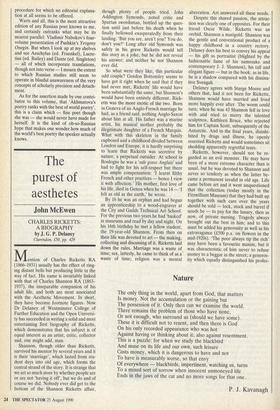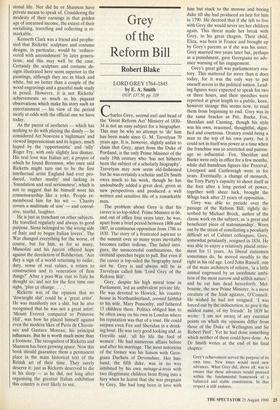The purest of aesthetes
John McEwen
CHARLES RICKETTS: A BIOGRAPHY by J. G. P. Delaney
Clarendon, LSO, pp. 429
Mention of Charles Ricketts RA (1866-1931) usually has the effect of ring- ing distant bells but producing little in the way of fact. His name is invariably linked with that of Charles Shannon RA (1863- 1937), the inseparable companion of his adult life, and both are most associated with the Aesthetic Movement. In short, they have become footnote figures. Now Dr Delaney of Westminster College of Further Education and the Open Universi- ty has succeeded in writing a solid and most entertaining first biography of Ricketts, which demonstrates that his subject is of equal interest as an artist, critic, collector and, one might add, man.
Shannon, though older than Ricketts, survived his mentor by several years and it is their 'marriage', which lasted from stu- dent days into old age, which forms the central strand of the story. It is strange that we set so much store by whether people are or are not 'having it off, but we do and of course we did. Nobody ever did get to the bottom of the Shannon Ricketts affair, though plenty of people tried. John Addington Symonds, noted critic and Spartan swordsman, bottled up the ques- tion until just before his death when he finally bellowed exasperatedly from their landing: 'But you are, aren't you? You do, don't you?' Long after old Symonds was safely in his grave Ricketts would tell this story as a joke, but he did not reveal his answer; and neither he nor Shannon ever did.
So what were they like, this particular odd couple? Gordon Bottomley seems to have got it right when he said that if they had never met, Ricketts' life would have been substantially the same, but Shannon's would have been entirely different. Rick- etts was the more exotic of the two. Born in Geneva of an Anglo-French marriage he had, as a friend said, nothing Anglo-Saxon about him at all. His father was a marine artist, his musical mother probably the illegitimate daughter of a French Marquis. What with this skeleton in the family cupboard and a childhood divided between London and Europe, it is hardly surprising to learn that Ricketts was secretive by nature, a perpetual outsider. At school in Boulogne he was a 'sale gosse Anglais' and had to fight for his self-respect but there was ample compensation: 'I learnt filthy French and other practices — hence I view it with affection.' His mother, first love of his life, died in Genoa when he was 14 — 'I felt as old as the earth,' he wrote.
By 16 he was an orphan and had begun an apprenticeship to a wood-engraver at the City and Guilds Technical Art School. For the previous two years he had 'basked' in museums and read by day and night. On his 16th birthday he met a fellow student, the 19-year-old Shannon. From then on their life was devoted to art — the making, collecting and discussing of it. Ricketts laid down the rules. Marriage was a waste of time; sex, latterly, he came to think of as a waste of time; religion was a mental aberration. Art answered all these needs.
Despite this shared passion, the attrac- tion was clearly one of opposites. For their friend Oscar Wilde, Ricketts was an orchid, Shannon a marigold. Shannon was the gentle and conventional product of a happy childhood in a country rectory. Delaney does his best to convey his appeal — his gift as portraitist (blighted by the fashionable fame of his namesake and contemporary J. J. Shannon), his tall and elegant figure — but in the book, as in life, he is a shadow compared with his diminu- tive Svengali.
Delaney agrees with Sturge Moore and others that, had it not been for Ricketts, Shannon would have married and lived more happily ever after. The worm could turn; when he was 43 Shannon fell in love with and tried to marry the talented sculptress, Kathleen Bruce, who rejected him for Captain Scott, subsequently of the Antarctic. And in the final years, disinhi- bited by drugs and illness, he openly resented Ricketts and would sometimes sit shedding apparently regretful tears.
Ricketts, however, should not be re- garded as an evil monster. He may have been of a more extreme character than is usual, but he was devoted to Shannon and never so tenderly as when the latter be- came a permanent invalid in old age. Life came before art and it went unquestioned that the collection (today mostly in the Fitzwilliam Museum) that they had built up together with such care over the years should be sold — lock, stock and barrel if needs be — to pay for the luxury, then as now, of private nursing. Tragedy always brought out the best in him; and to this must be added his generosity as well as his extravagance (£500 p.a. on flowers in the mid-1920s). 'The poor always tip the rich' may have been a favourite maxim, but it was characteristic of him never to refuse money to a beggar in the street; a generos- ity which equally distinguished his profes- sional life. Nor did he or Shannon have private means to speak of. Considering the modesty of their earnings in that golden age of unearned income, the extent of their socialising, travelling and collecting is re- markable.
Kenneth Clark was a friend and prophe- sied that Ricketts' sculpture and costume designs, in particular, would be `redisco- vered with astonishment' by later genera- tions; and this may well be the case. Certainly the sculpture and costume de- signs illustrated here seem superior to the paintings, although they are in black and white, but no better than a couple of the wood engravings and a graceful nude study in pencil. However, it is not Ricketts' achievements so much as his piquant observations which make his story such an entertainment — his view of the period nicely at odds with the official one we have today.
As the purest of aesthetes — which has nothing to do with playing the dandy — he considered Art Nouveau a `nightmare' and viewed Impressionism and its legacy, much hyped by the `opportunistic' and 'silly' Roger Fry, with only slightly less dismay. His real love was Italian art; d propos of which he found Berenson, who once said Ricketts might turn out to be the first intellectual artist England had ever pro- duced, 'rather mushy' and lacking in `foundation and real seriousness'; which is not to suggest that he himself wore his connoisseurship like a yoke. People re- membered him for his wit — `Charity covers a multitude of sins' — and convul- sive, tearful, laughter.
He is just as trenchant on other subjects. He travelled regularly and always to good purpose. Siena belonged to 'the wrong side of Italy and to bogus Italian lovers'. The War changed everything for the worse, of course, but for him, as for so many, Mussolini and his fascisti offered hope against the dereliction of Bolshevism. 'Are they a sign of a world returning to order, duty, sense of real values, a return to construction and to veneration of firm things?' After a post-War visit to Italy he thought so; and not for the first time one sighs, 'plus ca change. . .
Ricketts was of the opinion that no 'downright shit' could be a 'great artist'. He was manifestly not a shit, but he also recognised that he was not a great artist: `Mount Everest compared to Primrose Hill', was how he placed himself against even the modern likes of Puvis de Chavan- nes and Gustave Moreau, his principal influences. But he is worth much more than a footnote. The recognition of Ricketts and Shannon has been growing apace. Now this book should guarantee them a permanent place in the main historical text of the British art of their time. They surely deserve it; just as Ricketts deserved to die
in his sleep — as he did, not long after organising the greatest Italian exhibition this country is ever likely to see.











































 Previous page
Previous page